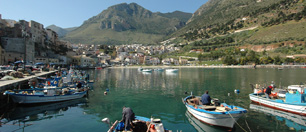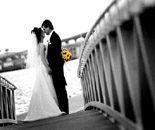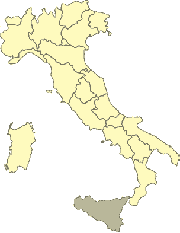
There are few places in the Mediterranean that can equal Sicily's (Sicilia) striking landscapes and colorful history. There are noticeable differences between the eastern part of the island, culturally of Greek origin, and the Phoenician and Arab western side. However, Sicily is much more than an east-west side, every village and town has its own unique story. You can identify different layers of civilization side by side or overlapping one another. It is not that uncommon to see Greek, Arab, Norman, and Baroque influences in the same site, sometimes in the same building!
The ancient name for Sicily, “Trinacria” (a three-cornered island) is aptly named. Sicilian shores are washed by three different seas: Ionian Sea, Tyrrhenian Sea, and the Mediterranean. Sicily is the largest island in the Mediterranean, and is in some aspects its focal point, home to heavenly beaches, majestic mountains, and Europe’s largest natural wonder, Mount Etna. The main island is surrounded by a number of smaller picturesque islands, including the Aeolian islands to the west and the Pelagie islands to the south.
The typical landscape consists of coast and sun-baked hills and its geographical make-up is also quite varied, with sulfur mines in the center and volcanic activity in the east. Sicily's many volcanoes, in particular Mount Etna (the largest in Europe) have created a landscape that is unique in the Mediterranean. Sicily's coasts are gold with orange and lemon orchards; in northeastern Sicily you will find lush forests; in the central regions you'll encounter rugged land and rolling hills; vineyards, olive groves, almond orchards, and endless wheat fields.
The people of Sicily regard themselves as significantly different from the rest of Italy, especially in the matters of ethnicity, culture, and language: from the Greeks and Romans, to the Byzantines and Arabs, the Normans and the Spanish. This combination has made Sicily and its people unique, and these mixed roots are reflected in their dialect, cuisine, and architecture.
Sicily’s plentiful architecture provides a visual demonstration of its diversity. You can discover Greek temples and amphitheaters, Roman settlements, unique Norman-Arab churches and palaces, Byzantine churches, early Gothic churches, fortified medieval castles, Catalonian Gothic palaces, Baroque churches and mansions, and even a Chinese Revival villa built in the first years of the nineteenth century. Foundations of Phoenician buildings have been discovered beneath some of the Roman structures of Old Palermo, the hilltop temple at Cefalů is thought to be Sicanian, and the museum at Termini Imerese houses the stone Arabic inscriptions of 9th-century Saracen palaces.



 There are few places in the Mediterranean that can equal Sicily's (Sicilia) striking landscapes and colorful history. There are noticeable differences between the eastern part of the island, culturally of Greek origin, and the Phoenician and Arab western side. However, Sicily is much more than an east-west side, every village and town has its own unique story. You can identify different layers of civilization side by side or overlapping one another. It is not that uncommon to see Greek, Arab, Norman, and Baroque influences in the same site, sometimes in the same building!
There are few places in the Mediterranean that can equal Sicily's (Sicilia) striking landscapes and colorful history. There are noticeable differences between the eastern part of the island, culturally of Greek origin, and the Phoenician and Arab western side. However, Sicily is much more than an east-west side, every village and town has its own unique story. You can identify different layers of civilization side by side or overlapping one another. It is not that uncommon to see Greek, Arab, Norman, and Baroque influences in the same site, sometimes in the same building!
















